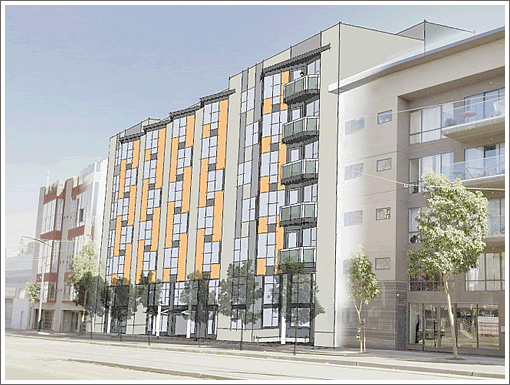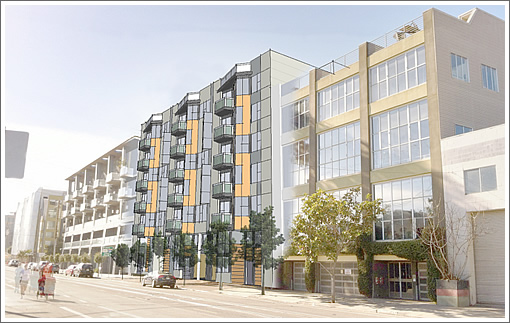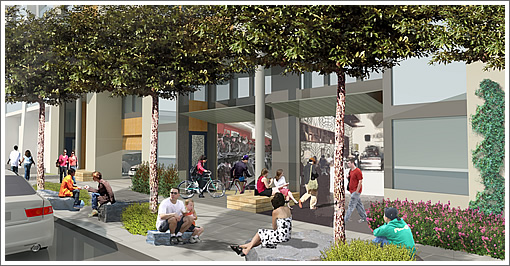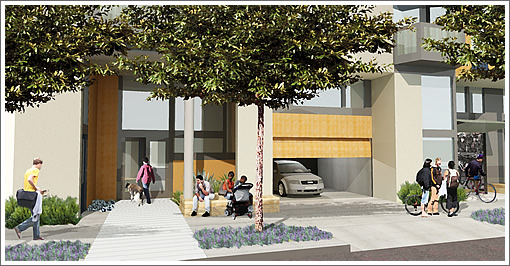
Plans for a six-story residential building to rise at 2051 3rd Street will be presented to San Francisco’s Planning Commission next week. The proposed Dogpatch development would raze two mid-block industrial buildings between Mariposa and 18th Streets, merge the parcels, and construct 94 new dwelling units with an underground garage on the site.

The development would front both Third (above) and Illinois (below) with a courtyard between.

As proposed, the 94 units would be rentals for at least 30 years with a mix of 35 studios, 21 one-bedrooms, 37 two-bedrooms and 1 three-bedroom. Two of the one-bedrooms would be ground floor “flex spaces” along Illinois:

Access to the garage with space for 74 cars would be by way of Illinois.

Parking for up to 102 bikes in the building is included as well.
A generic, high density mid-rise infill building. I love it. Builders in this country need a standardized, adaptable design for exactly this kind of building. Something that can be put up quickly on a site with known materials, timeline, labor, etc. .. and dozens or hundreds of known completed built examples. Something so routine it’s not controversial. The city equivalent of the anonymous suburban tract home. No surprises. Part of the background of the city. Build thousands more like it.
I’d make the parking an optional module in the standardized designs, though, replaced with a ground floor retail module.
Why not both? I read that in Brooklyn the city codes actually required the parking ‘module’ to be built in such a way that it could be used for other purposes in the future, if demand changed. That seems like a good compromise to me. The main effect of that requirement, I believe, was to maintain an adequate ceiling height, since that would be impossible to fix later.
Parking! Yes!
Yeah, parking can easily be converted to storage space. If it’s on the ground floor, maybe can be converted to more active uses… depends on the windows.
so…. every vacant lot in the city will be filled in with a mediocre, undistinguished resi structure built by a “b” builder no doubt.
these structures that actually look bad in renderings (its really easy to make a building render well…..), will look worse when built new, and 5 years down the road less less yet.
thats a great legacy, as woolie states, of the current economic boom. for SF to be built out like bland anonymous suburbia. good model to follow.
this is dot.com bubble version 2 and live work loft version 2.
lost opportunity.
Why don’t you buy a vacant lot and do something remarkable then, Louis? Don’t forget to bring your A game.
I don’t think it’s bland at all. It’s market rate and reflects costs today. Nothing wrong with some new housing being simple, modern and clean.
Tell us what you’d put up there Louis.
I echo the comments about the blandness (especially Louis’) of the rendering. Rarely does the finished product look better than the rendering. It is a lot like Bubble v 2. Do any of you really think that most of that SOMA work/live shite that was put up a decade ago or so during the first boom looks good now? Most of it looked dated to me when I moved here in 2003.
Flex units on Illinois? Put retail on Third, and then you are talking. . .
Woolie idea = bland, cheap looking housing, and would never fly in this city’s nimby-meets-anal-city-planning-dept.
Here’s what would help: streamline the approval/nimby “involvement” process, so developers can spend more dime on a decent design. With development so long and arduous, they too often skimp on design quality, just to make their numbers. Additionally, the low income housing impact fees are too arduous on the smaller 20-40 unit bldgs.
Thanks, woolie, for your commitment to turn one of America’s most beautiful cities into sh&t. Cretins everywhere applaud your get-rich-quick rush to the bottom.
^Yes, thank god we didn’t let those folks in the 1890s and 1910s throw up their Victorian and Edwardian BS all over town. I mean, we would have ended up with building after building that looked the same.
Saw this article in SPUR. Seems like the example building used by the architect in the article is very similar to what is being discussed for this site.
I have no clue on developer profits for such a building and how it rolls out per unit. Given the article, any guesses on the prices for the units?
http://www.spur.org/publications/article/2014-02-11/real-costs-building-housing
@PoorAss: Give me a break; developers don’t spend on design because they don’t think they get any return on it. Period. The idea that if permit process was streamlined, developers would all of a sudden get interested in design and spend money on that (while reducing their profits) is absurd. Obviously you have never talked to a developer or are just a shill for one.
You guys are hung up on facades. I don’t care about that. Make it modernist, or Victorian, or filled with bay windows. Maybe even cedar shingles. Whatever. That’s just decoration. I’m talking about the actual real square footage of residential space this city desperately needs. Lower the cost of building. How do you think this city was built in the first place? Every single house doing an EIR and surviving discretionary review? Some people say Brooklyn’s brownstone streets are some of the most beautiful in the country.
Stop talking nonsense NoeNutter. There are plenty of developments in SF where a completing design was a priority, incl. several in your own frickin neighborhood. Developers spend money and effort on design when they think it will help them get top dollar. That depends on numerous factors, like the neighborhood, market conditions, the capability of the developer/architect AND how arduous the permitting process will be. A prime example of a development getting dragged through the mud is the one next to the marsh theater. That is a prime location too. Bottom line is that “nice design” is a factor in the development process. And give me a break with your condescending attitude/shill for developer nonsense. I’m an independent SF RE investor/developer (small bldgs) that is knowledgeable on the subject. You are lucky to experience my wisdom and words of wit.
For the most part realtor/developer types in this town, who are dealing with small projects simply do not put much importance on design.
They are out to get as much ROI as they can.
They generally are not knowledgeable about architecture and “good” modern design. That’s just not their focus.
Architects struggle all the time to convince those type of clients to “care” even a little bit about design and quality. It’s often an uphill battle.